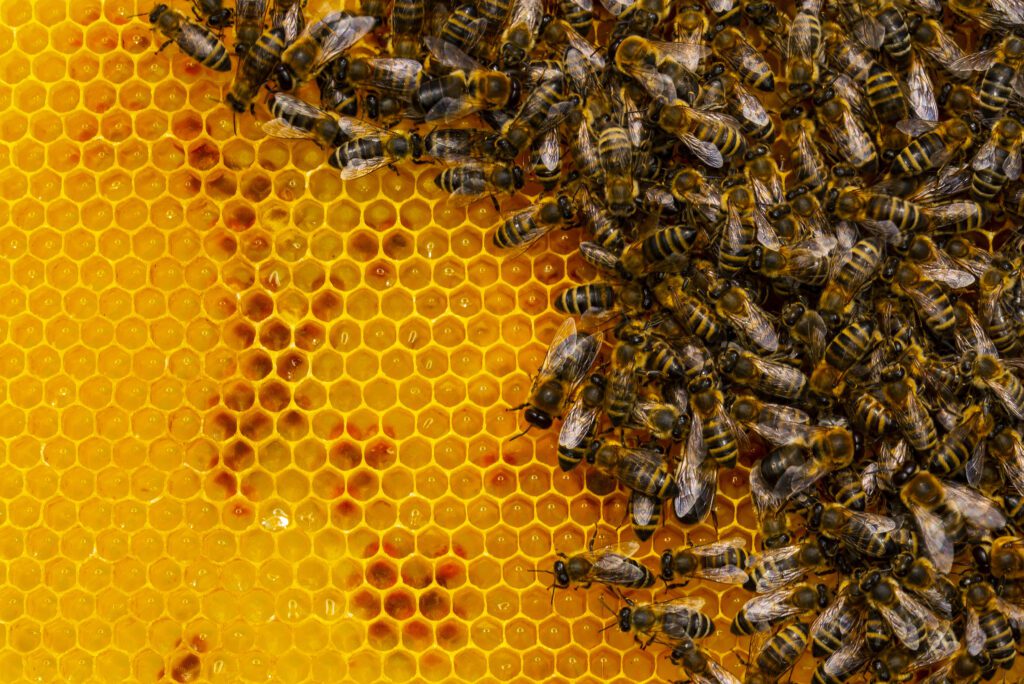
by LUIS RODRIGUEZ, UF/IFAS Polk Extension
Honey bees play a critical role in Florida’s agricultural industry. To ensure the sustainability of their colonies, beekeepers must continuously monitor the colony health, as various stressors, both internal and external, can adversely impact bee behavior and physiology. If left unmanaged, these stressors can compromise colony resilience, increasing susceptibility to disease and collapse. A thorough understanding of these factors is essential for beekeepers and farmers committed to maintaining pollinator health and productivity.
What Is a Honey Bee Stressor?
A stressor is any factor that disrupts the equilibrium of a honey bee colony, negatively affecting its resilience and capacity to thrive. These stressors are composed of a wide range of environmental and biological challenges, including adverse weather conditions, queen failure, pests, and diseases. The impact of a particular stressor is influenced by various factors such as location, season, colony strength, and the management practices used by the beekeeper.
Stressors are generally classified as low, moderate, or significant according to the severity of the threat they present. However, the perceived level of threat is not fixed and may vary based on specific circumstances; what may be a minor inconvenience for one beekeeper may pose a substantial risk for another.
Significant Threat
When these stressors are present, they often require immediate intervention by the beekeeper to prevent colony loss. These stressors include:
- Starvation and Poor-Quality Forage – Honey bee colonies are at risk of starvation when essential resources such as nectar, pollen, and water are insufficient or of low quality. A lack of adequate forage in a given location can have serious consequences for colony health and productivity. It is crucial for beekeepers to recognize when supplemental feeding is necessary and to provide appropriate nectar and pollen substitutes when natural sources are lacking.
Importantly, the mere presence of flowering plants near an apiary does not guarantee that nectar or pollen is available in sufficient quantity or quality. Beekeepers must be able to identify which plant species serve as reliable sources of high-quality nectar and pollen in order to accurately assess forage conditions and make informed decisions about supplemental feeding. Please access this publication for Florida Honey Bee Plants:
- Honey Bee Queen Issues – A poor-quality queen, characterized by insufficient egg-laying, inadequate pheromone production, or an inconsistent brood pattern, can significantly impact the health and survivability of a bee colony. Additionally, a dead or absent queen, or one with unfavorable genetics, can compromise colony stability. It is essential for beekeepers to regularly monitor the condition of their queen and replace her as necessary. For commercial operations, it is generally recommended to replace queens every six months to maintain colony productivity and health.
When a queen is not releasing enough pheromones or a colony becomes queenless, beekeepers may observe laying workers. These workers can be identified by the presence of two eggs in the same cell. Since worker bees do not mate, their unfertilized eggs develop into drones. Colonies with laying workers and no queen are unlikely to survive, but introducing a mated queen can effectively resolve this issue.
- Cold Weather – Cold weather poses significant risks to honey bee colonies, as exposure to extreme or prolonged low temperatures can be detrimental, particularly for weaker colonies that may succumb during harsh winter conditions. Although honey bees possess the ability to thermoregulate within the hive to maintain optimal internal temperatures, it remains essential to prepare colonies for the winter season. Furthermore, it is advisable to avoid opening hives when environmental temperatures fall below 55 degrees Fahrenheit, as this can cause undue stress and jeopardize colony health.
- Pests and Diseases – Pests such as Varroa mites, small hive beetles, and wax moths can significantly compromise the health of a bee colony, potentially leading to colony collapse if not managed effectively. Varroa mites, in particular, act as vectors for diseases like deformed wing virus, further undermining colony viability. Additionally, bacterial infections such as foulbrood pose serious threats to colony health, often resulting in substantial losses for beekeepers. Consequently, beekeepers must conduct regular and thorough inspections of their hives to detect and address pest infestations and diseases promptly, thereby ensuring the sustained health and productivity of their colonies.
Moderate Threat
Moderate threats are potential stressors to honey bee colonies that depend on the region and other environmental/external conditions. Some moderate stressors are:
- Pesticides – The misuse of pesticides can harm bees, so beekeepers must take precautions to protect their hives. Minimizing pesticide exposure includes communicating with neighbors and farmers to coordinate spraying schedules and moving bees if necessary. It is recommended to avoid spraying attractive blooms or water sources, and apply pesticides at night when pollinators are less active.
- Weather – Weather conditions significantly impact bee health and activity. Drought limits water access and reduces flower blooms, while excessive rain can cause flooding, hinder queen mating flights, and restrict worker foraging. Though wind and heat are less severe, they can still disrupt hive stability and affect weaker colonies; proper ventilation and secure hive placement are essential.
- Robbing Bees – Robbing occurs when external bees attempt to steal honey from colonies, especially during late summer and early fall when resources are scarce. A strong, healthy colony can usually defend against robbers, but these intruders may introduce pests and diseases. Using an entrance excluder can help prevent robbing and protect the hive.
- Honey Bee Transport – Moving bees, especially over long distances, can cause significant stress as they may be unable to fly for hours or even days, and restricted airflow can lead to overheating within the colony. To minimize these risks, it is essential to make all necessary preparations and transport the bees early in the morning before sunrise. Proper timing and care are crucial to ensuring the health and safety of the colony during relocation.
- Ventilation – A lack of ventilation can lead to high humidity inside the hive, creating conditions that may cause the nest to overheat. To prevent this, it is important to use mesh bottom boards and avoid overly restricting the hive entrance, especially during Florida’s summer season.
- Queen Supersedures – Supersedure cells may indicate a colony experiencing stress, such as overcrowding or an effort to replace an aging or suboptimal queen, often leading to swarming behavior. Upon detection, it is advisable to inspect the queen, remove any queen cups, and replace the queen if necessary to ensure colony stability.
Low Threat
These are rarely a major problem, but can significantly stress honey bees when conditions are met. Some low-threat stressors are:
- Small Colonies – Small colonies, such as nucs, are more vulnerable to stress. However, with proper care and management, these smaller colonies can develop and strengthen over time, ultimately reducing their susceptibility to stress.
- Swarming – Swarming is a natural way for bee colonies to reproduce, but beekeepers often try to prevent it to avoid losing a large portion of their bees. Bees typically swarm due to other stressors such as limited space, insufficient resources, or external disturbances.
- Toxic Nectar – Bees rarely encounter problems, but occasionally they may collect nectar from plants that produce toxins. In such cases, it’s best to limit their access to these harmful sources. An example of a plant that has toxic nectar for bees is Yellow Jessamine.
- Working Bees Too Much or Too Little – Working bees too often can stress them and increase the chance of swarming. To keep them healthy, work your bees every 15 days, or every 10 days during swarming season. On the other hand, neglecting regular care can lead to problems like swarming, pests, and diseases.

Monitor & Manage
Honey bee colonies face various stressors that threaten their health and survival, such as food shortages, pests, diseases, weather, and queen problems. Beekeepers must monitor and manage these challenges carefully to keep colonies strong and productive. Understanding these stressors is key to protecting bees and supporting Florida’s agriculture.
For more information about honey bee stressors, please access the following beekeeping publication by Dr. Jamie Ellis called “Biotic Stressors of Honey Bees” and “Other Stressors of Honey Bees.”
Note: This publication is based on the 2 publications mentioned above.
Luis Rodriguez is the Polk County Small Farms and Pesticide Education Extension Agent. You can reach him at lrodriguezrosado@ufl.edu or 863-519-1049.

